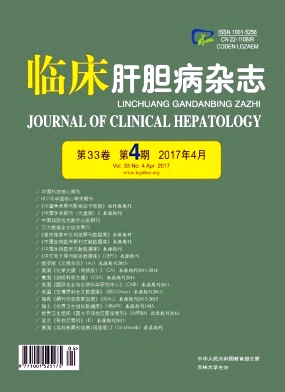|
[1]TORO A, MAHFOUZ AE, ARDIRI A, et al.What is changing in indications and treatment of hepatic hemangiomas.A review[J].Ann Hepatol, 2014, 13 (4) :327-339.
|
|
[2]ZOU H, MA KS.Current situation on radiofrequency ablation of hepatic hemangioma[J].J Clin Hepatol, 2013, 29 (8) :567-569. (in Chinese) 邹华, 马宽生.射频消融治疗肝血管瘤的现状[J].临床肝胆病杂志, 2013, 29 (8) :567-569.
|
|
[3]GIULIANTE F, ARDITO F, VELLONE M, et al.Reappraisal of surgical indications and approach for liver hemangioma:singlecenter experience on 74 patients[J].Am J Surg, 2011, 201 (6) :741-748.
|
|
[4]DONATI M, STAVROU GA, DONATI A, et al.The risk of spontaneous rupuure of liver hemangioma:a critical review of the literature[J].J Gastrointest Surg, 2011, 15 (1) :209-214.
|
|
[5]GAO J, SUN WB.Modern views on surgical treatment of hepatic hemangioma[J].Chin J Med, 2014, 49 (12) :13-15. (in Chinese) 高君, 孙文兵.肝血管瘤外科治疗的现代观[J].中国医刊, 2014, 49 (12) :13-15.
|
|
[6]WU ZB, HUANG ZY.Indications and methods for surgical treatment of hepatic hemangioma[J].J Clin Surg, 2014, 22 (8) :616-618. (in Chinese) 吴珍宝, 黄志勇.肝血管瘤外科治疗的指征与方法[J].临床外科杂志, 2014, 22 (8) :616-618.
|
|
[7]SCHNELLDORFER T, WARE AL, SMOOT R, et al.Management of giant hemangioma of the liver:resection versus observation[J].J Am Coll Surg, 2010, 211 (6) :724-730.
|
|
[8]YEDIBELA S, ALIBEK S, MULLER V, et al.Management of hemangioma of the liver:surgical therapy on observation?[J].World J Surg, 2013, 37 (6) :1303-1312.
|
|
[9]WAGN KY, FU HQ.Surgical treatment and operative indication of hepatic hemangioma[J].Chin J Hepatobiliary Surg, 2011, 17 (9) :701-702. (in Chinese) 王开阳, 傅华群.肝血管瘤的外科治疗现状及手术指征[J].中华肝胆外科杂志, 2011, 17 (9) :701-702.
|
|
[10]DONG J, ZHU Y, WANG WL, et al.Hepatic hemangoma treated by surgical resection:a analysis of 128 patients[J].Chin J Hepatobiliary Surg, 2014, 20 (8) :595-598. (in Chinese) 董建, 朱迎, 王万里, 等.肝血管瘤128例外科治疗分析[J].中华肝胆外科杂志, 2014, 20 (8) :595-598.
|
|
[11]LERNER SM, HIATT JR, SALAMANDRA J, et al.Giant cavernous liver hemangiomas:effect of operative approach on outcome[J].Arch Surg, 2004, 139 (8) :818-821, 821-823.
|
|
[12]CHENG JJ, MA JL.Treatment progress in adult hepatic cavernous hemangioma[J].Med Recapitulate, 2013, 19 (11) :2020-2022. (in Chinese) 程炯炯, 马金良.成人肝海绵状血管瘤的治疗进展[J].医学综述, 2013, 19 (11) :2020-2022.
|
|
[13]DOU KF, JIN C.Prowess in surgery for hemangioma of liver[J].Chin J Dig Surg, 2013, 12 (1) :13-15. (in Chinese) 窦科峰, 金成.肝血管瘤外科治疗进展[J].中华消化外科杂志, 2013, 12 (1) :13-15.
|
|
[14]ZHOU CM, ZHANG JH, REN WX, et al.Treatment and clinical grading system of liver hemangioma among 514 patients[J].Chin J Dig Surg, 2015, 14 (2) :102-105. (in Chinese) 周成明, 张金辉, 任伟新, 等.514例肝血管瘤的治疗与临床评分[J].中华消化外科杂志, 2015, 14 (2) :102-105.
|
|
[15]ZHU Q, QIAO GL, YAN JJ, et al.New perspectives on the natural history and growth pattern of hepatic hemangioma in adults:a cohort study[J].Chin J Hepatobiliary Surg, 2015, 21 (11) :721-725. (in Chinese) 朱倩, 乔国梁, 晏建军, 等.对成人肝血管瘤自然发展进程及生长方式的新认识:队列研究[J].中华肝胆外科杂志, 2015, 21 (11) :721-725.
|
|
[16]GENG XP.Hepatic hemangioma and precise surgical treatment[J].Chin J Bases Clin Gen Surg, 2016, 23 (2) :137-139. (in Chinese) 耿小平.肝血管瘤与精准外科治疗[J].中国普外基础与临床杂志, 2016, 23 (2) :137-139.
|
|
[17]QIU MQ.Comparison of curative effect by resection of hepatic hemangioma and traditional operation of stripping[J].China Med Herald, 2014, 11 (19) :65-68. (in Chinese) 邱明权.肝血管瘤传统手术切除和剥离术疗效对比[J].中国医药导报, 2014, 11 (19) :65-68.
|
|
[18]MUAMMADCUMA DX, WEN H.Advances in surgical diagnosis and treatment of hepatic hemangioma[J].Xinjiang Med J, 2011, 41 (1) :91-95. (in Chinese) 买买提居马·对先, 温浩.肝血管瘤外科诊治进展[J].新疆医学, 2011, 41 (1) :91-95.
|
|
[19]QIN XL, XU J, DI WD, et al.Laparoscopic treatment of hepatic hemangioma on the operation method and curative effect of comparative analysis[J/CD].Chin J Laparoscopic Surgery:Electronic Edition, 2014, 7 (5) :350-353. (in Chinese) 秦学良, 徐钧, 底卫东, 等.腹腔镜治疗肝血管瘤手术方式选择及疗效的比较分析[J/CD].中华腔镜外科杂志:电子版, 2014, 7 (5) :350-353.
|
|
[20]WU X, XIA H, WU J, et al.Clinical experience in treatment of complex intrahepatic bile duct stones by regular hepatectomy[J].J Clin Hepatol, 2016, 32 (9) :1756-1759. (in Chinese) 吴晓, 夏灏, 吴健, 等.规则肝切除术治疗复杂肝内胆管结石的临床体会[J].临床肝胆病杂志, 2016, 32 (9) :1756-1759.
|
|
[21]LI LH, WANG JW, LIU B, et al.Clinical application of three-dimensional reconstruction in preoperative evaluation of hepatectomy[J].J Clin Hepatol, 2016, 32 (5) :938-941. (in Chinese) 李连海, 王建伟, 刘斌, 等.三维重建在肝切除术前评估中的临床应用效果[J].临床肝胆病杂志, 2016, 32 (5) :938-941.
|









 本站查看
本站查看




 DownLoad:
DownLoad: